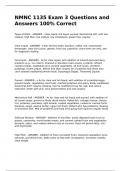NMNC 1135 Exam 3 Questions and
Answers 100% Correct
Types of Diets - ANSWER - Clear liquid, full liquid, pureed, Mechanical soft, soft/ low
residue, high fiber, low sodium, low cholesterol, gluten free, regular
Clear Liquid - ANSWER - Clear fat-free broth, bouillon, coffee, tea, carbonated
beverages, clear fruit juices, gelatin, fruit ices, popsicles, short term use only, and
for diagnostic testing
Full Liquid: - ANSWER - As for clear liquid, with addition of smooth-textured dairy
products (e.g., ice cream), strained or blended cream soups, custards, refined
cooked cereals, vegetable juice, pureed vegetables, all fruit juices, sherbets,
puddings, frozen yogurt. Before and after surgery for ill patients and those who
can't tolerate swallowing whole foods. Dysphagia Stages, Thickened Liquids
Pureed - ANSWER - o As for clear and full liquid, with addition of scrambled eggs;
pureed meats, vegetables, and fruits; mashed potatoes and gravy. Easily swallowed
foods that don't require chewing. Can be modified to low fat, salt, and calorie
reduction. Order with oral, neck abnormalities and oral surgery
Mechanical Soft - ANSWER - As for clear and full liquid and pureed, with addition of
all cream soups, ground or finely diced meats, flaked fish, cottage cheese, cheese,
rice, potatoes, pancakes, light breads, cooked vegetables, cooked or canned fruits,
bananas, soups, peanut butter, eggs (not fried), Patient who has problems chewing
or transition diet. Mild GI problems and hard time going from liquid to regular foods
Soft/Low Residue - ANSWER - Addition of low-fiber, easily digested foods such as
pastas, casseroles, moist tender meats, and canned cooked fruits and vegetables;
desserts, cakes, and cookies without nuts or coconut. Does not permit fatty, rich,
and fried foods.
High Fiber - ANSWER - Addition of fresh uncooked fruits, steamed vegetables, bran,
oatmeal, and dried fruits. Adds carbs to help with constipation. Increases motility
stool weight.
,Low Sodium - ANSWER - o 4-g (no added salt), 2-g, 1-g, or 500-mg sodium diets;
vary from no-added-salt to severe sodium restriction (500-mg sodium diet), which
requires selective food purchases
Low Cholesterol - ANSWER - o 300 mg/day cholesterol, in keeping with American
Heart Association guidelines for serum lipid reduction
Diabetic - ANSWER - o : Nutrition recommendations by the American Diabetes
Association: focus on total energy, nutrient and food distribution; include a balanced
intake of carbohydrates, fats, and proteins; varied caloric recommendations to
accommodate patient's metabolic demands
Gluten Free - ANSWER - Eliminates wheat, oats, rye, barley and their derivatives
Regular - ANSWER - o No restrictions unless specified
Assisted Dining - ANSWER - two handled cups
wide base cup
plate with plate guard and non-skid bottom
large-handled flatware
identify the food location on a meal plate as if it were a clock (e.g., meat at 9 o'clock
and vegetable at 3 o'clock
Microscopic examination RBC - ANSWER - o (up to 2)
§ Damage to glomeruli or tubules allows RBCs to enter the urine. Trauma, disease,
presence of urethral catheters, or surgery of the lower urinary tract also causes
RBCs to be present.
WBCs - ANSWER - o (0-4 per low-power field)
§ Elevated numbers indicate inflammation or infection.
Bacteria - ANSWER - o (not normally present)
, § Bacteria in the urine can mean infection or colonization (if the patient shows no
symptoms)
Nutritional needs of the older adult - ANSWER - o Obtain nutrients needed by the
body such as potassium, calcium, vitamin D, vitamin B12, minerals, and dietary
fiber.
o Lose weight or maintain a healthy weight
o Reduce the risk of developing chronic diseases such as high blood pressure,
diabetes, hypertension, and heart disease. If you have a chronic disease, eating well
can help to manage the disease.
o Meet individual calorie and nutrition needs.
o Help to maintain energy levels.
Steps to blood glucose testing and safety - ANSWER - 1. Assess area of skin that you
will use as puncture site (e.g., fingers or heel). Alternative sites are palm, arm, or
thigh. Avoid areas of bruising and open lesions.
2. Choose puncture site. Puncture site should be vascular. In stable adults select
lateral side of finger; be sure to avoid central tip of finger, which has more dense
nerve supply.
3. Hold area to be punctured in dependent position. Do not milk or massage site.
4. Wipe site with antiseptic swab and allow it to dry completely.
5. Hold lancet perpendicular to puncture site and pierce finger or heel quickly in one
continuous motion (do not force lancet).
6. Wipe away first drop of blood with cotton ball.
Obtain test results.
Nasogastric Tube Intubation - ANSWER - 1. Stand on same side of bed as naris
chosen for insertion and help patient to high-Fowler's position unless
contraindicated. Place pillow behind head and shoulders. If patient is comatose,
raise HOB as tolerated in semi-Fowler's position with head tipped forward, using a
pillow chin to chest. If necessary, have NAP assist. If patient is forced to lie supine,
place in reverse Trendelenburg's position.
2. Place bath towel over patient's chest. Keep facial tissues within reach.
3. Determine length of tube to be inserted and mark with tape.
4. Hand an alert patient a cup of water if able to hold cup and swallow.




